Media Messages
There are different types of media messages that a bot can send (photos, videos, documents…). Fortunately, methods for sending such messages are similar (see sections below for examples)
But let’s first see what they have in common.
Providing the source file
You can provide the file data in 3 ways:
- Using the Internet URL to the file (must point to the actual file, not an HTML webpage)
- Uploading the file data as a stream
- Using the
FileIdof a file that was already sent over Telegram (ex:msg.Video.FileId,msg.Photo[^1].FileId…)
Examples in this section show all three. You will learn more about them later on when we discuss file upload and download.
Providing the caption
Media messages can optionally have a text attached to them (called “Caption”).
Similar to text message, the caption can have text effects (specifying ParseMode.HTML or Markdown, or manual captionEntities)
The Message object returned by the Send* method will have:
message.Caption: caption in plain text without effectsmessage.CaptionEntities: list of text effects to be applied to the plain textmessage.CaptionEntityValues: caption text parts covered by these entities
You can use our extension methods message.ToHtml() or message.ToMarkdown() to convert the caption & entities of a Message back into HTML (recommended) or Markdown.
Photo
Sending a photo is simple. Here is an example:
var message = await bot.SendPhoto(chatId, "https://telegrambots.github.io/book/docs/photo-ara.jpg",
"<b>Ara bird</b>. <i>Source</i>: <a href=\"https://pixabay.com\">Pixabay</a>", ParseMode.Html);
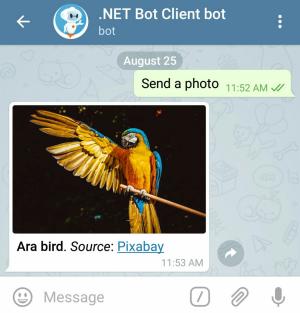
Here we sent a caption in HTML format. The user can click on Pixabay in the caption to open its URL in the browser.
The Message returned by the SendPhoto method represents a photo message because message.Photo has a value.
Its value is an array with each PhotoSize representing the same photo in different resolutions, with the largest dimensions last.
Sticker
Telegram stickers are fun. They can be static (PNG or WebP format), animated or video stickers
This code sends the same sticker twice. First by passing an URL to a WebP sticker file
and second by reusing FileId of the same sticker on Telegram servers.
var message1 = await bot.SendSticker(chatId, "https://telegrambots.github.io/book/docs/sticker-fred.webp");
var message2 = await bot.SendSticker(chatId, message1.Sticker!.FileId);

Video
You can send video via MP4 files (other formats may not be supported natively by Telegram clients and can be sent as Document)
Let’s send it differently this time by uploading the file from disk. To run this example, download the Hawk video to your disk.
await using Stream stream = File.OpenRead("./video-hawk.mp4");
await bot.SendVideo(chatId, stream);
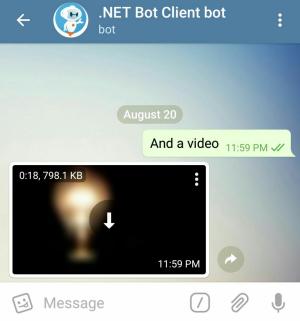
Videos, like other multimedia messages, can have caption, reply, reply markup, and etc. You can optionally specify the duration and resolution of the video.
In the example below, we send a video of a 10 minute countdown and expect the Telegram clients to stream that long video instead of downloading it completely. We also set a thumbnail image for our video.
await bot.SendVideo(chatId, "https://telegrambots.github.io/book/docs/video-countdown.mp4",
thumbnail: "https://telegrambots.github.io/book/2/docs/thumb-clock.jpg", supportsStreaming: true);
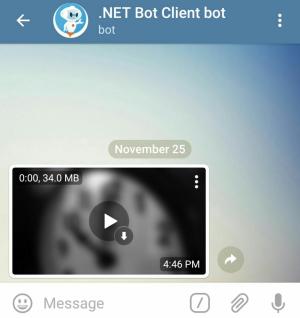
User should be able to seek through the video without the video being downloaded completely.
Audio
Here is the code to send an MP3 soundtrack.
var msg = await bot.SendAudio(chatId, "https://telegrambots.github.io/book/docs/audio-guitar.mp3"
// , performer: "Joel Thomas Hunger", title: "Fun Guitar and Ukulele", duration: 91 // optional
);
You might be wondering why some parameters are commented out? That’s because this MP3 file has metadata on it and Telegram does a good job at reading it.
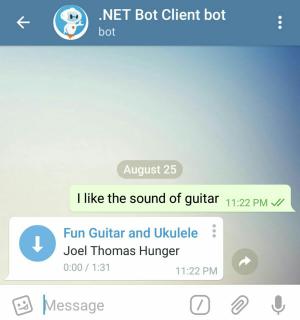
The method returns an audio Message with the metadata associated with the audio (ex: msg.Audio.Performer, msg.Audio.Duration…)
Voice
A voice message is similar to audio but has OGG format and is not shown in music player.
Here we pass a value for duration because Telegram can’t figure that out from a file’s metadata.
var msg = await bot.SendVoice(chatId, "https://telegrambots.github.io/book/docs/voice-nfl_commentary.ogg", duration: 36);
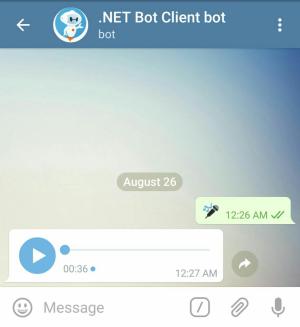
A voice message is returned from the method. Inspect the msg.Voice properties to learn more.
Video Note
Sending video notes is similar to video, but they are shown in circles to the user, usually short (1 minute or less) with identical width and height.
Note: Sending video note via an URL is not supported currently.
Download the Sea Waves video to your disk for this example.
await using Stream stream = File.OpenRead("path/to/video-waves.mp4");
await bot.SendVideoNote(chatId, stream, duration: 47, length: 360); // length = width = height
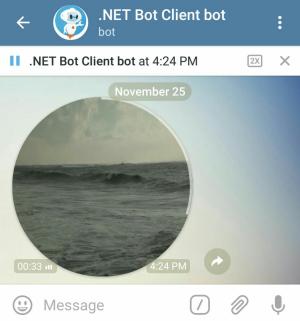
Document (files)
Use SendDocument method to send general files.
await bot.SendDocument(chatId, "https://telegrambots.github.io/book/docs/photo-ara.jpg",
"<b>Ara bird</b>. <i>Source</i>: <a href=\"https://pixabay.com\">Pixabay</a>", ParseMode.Html);
Using SendDocument to send a photo or video ensure that the file data is unchanged (not recompressed and metadata are preserved)
Animation (GIF or gifv)
Use SendAnimation method to send animation files (GIF or H.264/MPEG-4 AVC video without sound).
await bot.SendAnimation(chatId, "https://telegrambots.github.io/book/docs/video-waves.mp4", "Waves");
Media group (album of multiple media)
Using SendMediaGroup method you can send a group of photos, videos, documents or audios as an album. Documents and audio files can be only grouped in an album with messages of the same type.
var messages = await bot.SendMediaGroup(chatId, new IAlbumInputMedia[]
{
new InputMediaPhoto("https://cdn.pixabay.com/photo/2017/06/20/19/22/fuchs-2424369_640.jpg"),
new InputMediaPhoto("https://cdn.pixabay.com/photo/2017/04/11/21/34/giraffe-2222908_640.jpg"),
});
Note that media groups can’t have reply markup. The caption must be set on one of the media (usually the first)
Receiving a media group (album)
When your bot receives updates for a media group, it will appear as separate messages (one per media, usually consecutive) having the same MediaGroupId property.
You should collect them progressively as you receive those messages.
There is no way to know how many medias are in the album, so here are some techniques:
- look for consecutive messages in that chat with same
MediaGroupIdand stop when it’s not the same - stop after 10 medias in the group (maximum)
- use a timeout of a few seconds not receiving new messages in that chat to determine the end















